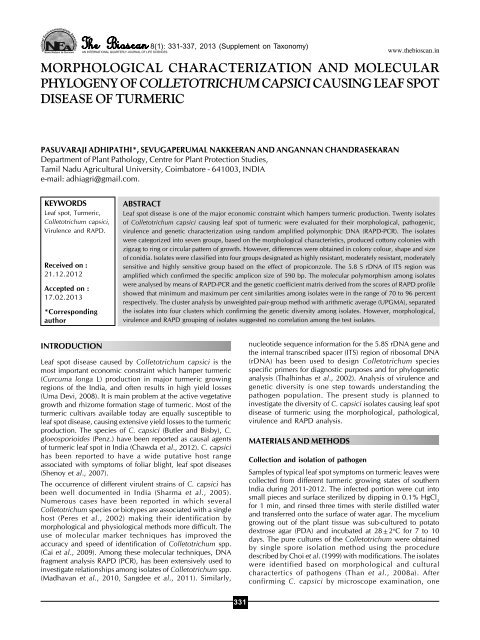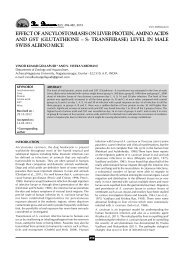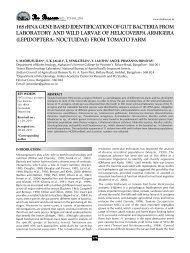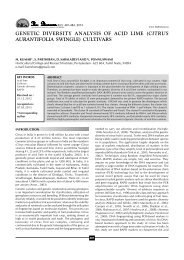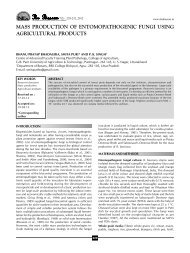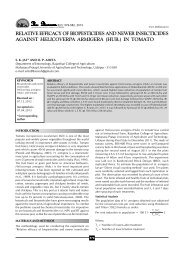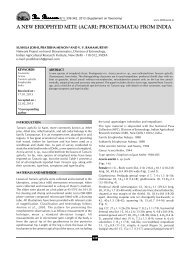Morphological characterization and molecular ... - THE BIOSCAN
Morphological characterization and molecular ... - THE BIOSCAN
Morphological characterization and molecular ... - THE BIOSCAN
- No tags were found...
Create successful ePaper yourself
Turn your PDF publications into a flip-book with our unique Google optimized e-Paper software.
NSave Nature to Survive8(1): 331-337, 2013 (Supplement on Taxonomy)www.thebioscan.inMORPHOLOGICAL CHARACTERIZATION AND MOLECULARPHYLOGENY OF COLLETOTRICHUM CAPSICI CAUSING LEAF SPOTDISEASE OF TURMERICPASUVARAJI ADHIPATHI*, SEVUGAPERUMAL NAKKEERAN AND ANGANNAN CHANDRASEKARANDepartment of Plant Pathology, Centre for Plant Protection Studies,Tamil Nadu Agricultural University, Coimbatore - 641003, INDIAe-mail: adhiagri@gmail.com.KEYWORDSLeaf spot, Turmeric,Colletotrichum capsici,Virulence <strong>and</strong> RAPD.Received on :21.12.2012Accepted on :17.02.2013*CorrespondingauthorABSTRACTLeaf spot disease is one of the major economic constraint which hampers turmeric production. Twenty isolatesof Colletotrichum capsici causing leaf spot of turmeric were evaluated for their morphological, pathogenic,virulence <strong>and</strong> genetic <strong>characterization</strong> using r<strong>and</strong>om amplified polymorphic DNA (RAPD-PCR). The isolateswere categorized into seven groups, based on the morphological characteristics, produced cottony colonies withzigzag to ring or circular pattern of growth. However, differences were obtained in colony colour, shape <strong>and</strong> sizeof conidia. Isolates were classified into four groups designated as highly resistant, moderately resistant, moderatelysensitive <strong>and</strong> highly sensitive group based on the effect of propiconzole. The 5.8 S rDNA of ITS region wasamplified which confirmed the specific amplicon size of 590 bp. The <strong>molecular</strong> polymorphism among isolateswere analysed by means of RAPD-PCR <strong>and</strong> the genetic coefficient matrix derived from the scores of RAPD profileshowed that minimum <strong>and</strong> maximum per cent similarities among isolates were in the range of 70 to 96 percentrespectively. The cluster analysis by unweighted pair-group method with arithmetic average (UPGMA), separatedthe isolates into four clusters which confirming the genetic diversity among isolates. However, morphological,virulence <strong>and</strong> RAPD grouping of isolates suggested no correlation among the test isolates.INTRODUCTIONLeaf spot disease caused by Colletotrichum capsici is themost important economic constraint which hamper turmeric(Curcuma longa L) production in major turmeric growingregions of the India, <strong>and</strong> often results in high yield losses(Uma Devi, 2008). It is main problem at the active vegetativegrowth <strong>and</strong> rhizome formation stage of turmeric. Most of theturmeric cultivars available today are equally susceptible toleaf spot disease, causing extensive yield losses to the turmericproduction. The species of C. capsici (Butler <strong>and</strong> Bisby), C.gloeosporioides (Penz.) have been reported as causal agentsof turmeric leaf spot in India (Chawda et al., 2012). C. capsicihas been reported to have a wide putative host rangeassociated with symptoms of foliar blight, leaf spot diseases(Shenoy et al., 2007).The occurrence of different virulent strains of C. capsici hasbeen well documented in India (Sharma et al., 2005).Numerous cases have been reported in which severalColletotrichum species or biotypes are associated with a singlehost (Peres et al., 2002) making their identification bymorphological <strong>and</strong> physiological methods more difficult. Theuse of <strong>molecular</strong> marker techniques has improved theaccuracy <strong>and</strong> speed of identification of Colletotrichum spp.(Cai et al., 2009). Among these <strong>molecular</strong> techniques, DNAfragment analysis RAPD (PCR), has been extensively used toinvestigate relationships among isolates of Colletotrichum spp.(Madhavan et al., 2010, Sangdee et al., 2011). Similarly,nucleotide sequence information for the 5.8S rDNA gene <strong>and</strong>the internal transcribed spacer (ITS) region of ribosomal DNA(rDNA) has been used to design Colletotrichum speciesspecific primers for diagnostic purposes <strong>and</strong> for phylogeneticanalysis (Thalhinhas et al., 2002). Analysis of virulence <strong>and</strong>genetic diversity is one step towards underst<strong>and</strong>ing thepathogen population. The present study is planned toinvestigate the diversity of C. capsici isolates causing leaf spotdisease of turmeric using the morphological, pathological,virulence <strong>and</strong> RAPD analysis.MATERIALS AND METHODSCollection <strong>and</strong> isolation of pathogenSamples of typical leaf spot symptoms on turmeric leaves werecollected from different turmeric growing states of southernIndia during 2011-2012. The infected portion were cut intosmall pieces <strong>and</strong> surface sterilized by dipping in 0.1% HgCl 2for 1 min, <strong>and</strong> rinsed three times with sterile distilled water<strong>and</strong> transferred onto the surface of water agar. The myceliumgrowing out of the plant tissue was sub-cultured to potatodextrose agar (PDA) <strong>and</strong> incubated at 28±2 o C for 7 to 10days. The pure cultures of the Colletotrichum were obtainedby single spore isolation method using the proceduredescribed by Choi et al. (1999) with modifications. The isolateswere identified based on morphological <strong>and</strong> culturalcharactertics of pathogens (Than et al., 2008a). Afterconfirming C. capsici by microscope examination, one331
P. ADHIPATHI et al.,Table 1: Sequences of RAPD primers used to study the geneticdiversity among isolates of Colletotrichum capsiciPrimerSequenceOPA1 5’- CAGGCCCTTC - 3’OPA2 5’- TGCCGAGCTG - 3’OPA3 5’- AGTCAGCCAC - 3’OPA4 5’- AATCGGGCTG - 3’OPA5 5’- AGGGGTCTTG - 3’OPA6 5’- GGTCCCTG AC - 3’OPA7 5’- GAAACGGGTG - 3’OPA8 5’- GTGACGTAGG - 3’OPA9 5’- GGGTAACGCC - 3’OPA10 5’- GTG ATCGCAG - 3’OPA11 5’- CAATCGCCGT - 3’OPA12 5’- TCGGCGATAG - 3’OPA13 5’- CAGCACCCAC - 3’OPA14 5’- TCTGTGCTGG - 3’OPA15 5’- TTCCGAACCC - 3’OPF01 5’- GGGAATTCGG - 3’OPF07 5’- CCGATATCCC - 3’OPF10 5’- GGAAGCTTGG - 3’monoconidial culture from each isolate was prepared <strong>and</strong>used in this study (Table 2).Examination of cultural <strong>and</strong> morphological characteristics:The isolates were cultured on PDA at 28 ± 2°C for 7 days,after which mycelial disks were transferred to the center of anew PDA medium. The colony morphology <strong>and</strong> colony colourof each isolate on PDA medium were examined daily from 5-10 days. For sporulation the culture were maintained in 12hour light <strong>and</strong> dark alternatively, then conidia were harvestedfrom each isolate <strong>and</strong> mounted in water. The size <strong>and</strong> shapeof twenty five conidia were measured under a image analyzer(LABOMED iVu5100, Labo America Inc, USA. Scope image9.0 exe, software 9.1v for spore measurement) light microscope(Sangdee et al., 2011).Pathogenicity test under in vitro <strong>and</strong> glasshouse condition:Pure cultures of each isolate are grown on PDA for 7–14 daysat 28±2°C under alternating 12 hour fluorescent light <strong>and</strong>12hour dark cycle to induce sporulation (Than et al., 2008b).The conidial suspension was harvested, filtered <strong>and</strong>centrifuged at 5000rpm. The mass of spore sedimentationwas collected, resuspended with sterilized distilled water <strong>and</strong>spore density was adjusted to a concentration of 1×10 6 spore/ml using a haemocytometer. Freshly collected immature <strong>and</strong>untreated leaves are washed under running tap water for 60seconds followed by surface sterilization by immersing theleaves in 70% ethanol for 3 minutes, 1% sodium hypochloritesolution for 3 minutes <strong>and</strong> then rinsing three times in steriliseddistilled water for 2 minutes each time <strong>and</strong> drying with steriletissue paper <strong>and</strong> then air drying (S<strong>and</strong>ers <strong>and</strong> Korsten, 2003;Montri et al., 2009). The surface sterilized turmeric leaveswere pinpricked with sterile needle then placed in the petridishwhich is equipped with moist cotton. The drop of 6μl of 10 6spores per ml was placed on the pinpricked or woundedspots <strong>and</strong> incubated in moist chamber at 26 o C <strong>and</strong> 95%relative humidity. The sterile water was used instead of sporesuspension served as a control under in -vitro condition. InTable 2: Cultural <strong>and</strong> morphological <strong>characterization</strong> of different isolates of C. capsici causing turmeric leaf spotIsolate Location Colony morphology Colony colour Conidia shape Morphology group Growth reduction( %) Virulence group RAPD groupCc1TNAU Erode-TN Zigzag cottony colonies, Smooth Grey Fusiform, Medium CC-I 32.55 CCV-I IVCc2TNAU Coimbatore -TN Circular cottony colonies Grey Fusiform, Medium CC-II 100.00 CCV-IV IVCg1TNAU Salem -TN Ring like zonation, Smooth White Fusiform, Large CC-III 100.00 CCV-II IICc3TNAU Dharmapuri -TN Zigzag cottony colonies, Smooth Grey Fusiform,Medium CC-I 42.77 CCV-II IVCc4TNAU Karur -TN Circular cottony colonies, Rough White Fusiform, Large CC-II 100.00 CCV-III IIICc5TNAU Namakkal -TN Ring like zonation,Rough Grey Fusiform, large CC-III 100.00 CCV-IV IIICc6TNAU Ksishanagiri -TN Zigzag cottony colonies, Smooth Grey Fusiform, Medium CC-I 81.97 CCV-II IVCg2TNAU Perumbalur -TN Round cottony colonies White Fusiform, Medium CC-III 29.36 CCV-II ICc7TNAU Villupuram -TN Zigzag colonies Grey Fusiform, Large CC-IV 6.87 CCV-I IVCg3TNAU Trichy -TN Circular, Smooth White Fusiform, Large CC-V 9.52 CCV-I ICc8TNAU Nizamabad – A.P Ring like growth, Grey Fusiform, Large CC-III 18.36 CCV-I IICc9TNAU Guntur – A.P Ring like growth, Rough Black Fusiform, Medium CC-VI 56.89 CCV-III IVCc10TNAU Warangal – A.P Zigzag colonies, Smooth Grey Fusiform, Medium CC-IV 13.68 CCV-I IVCc11TNAU Kozhikode - KL Zigzag zonation, Rough White Fusiform, Medium CC-VII 50.16 CCV-II IVCc12TNAU Palakkadu- KL Cicular Zonations, Rough White Fusiform, Large CC-II 56.45 CCV-III IVCc13TNAU Wayanad - KL Zigzag cottony colonies, smooth Light brown Fusiform, medium CC-I 24.60 CCV-II IVCc14TNAU Belgaum - KA Zigzag colonies, smooth Grey Fusiform, Large CC-IV 16.84 CCV-I IIICc15TNAU Mysore - KA Ring like zonation, Rough Grey Fusiform, Medium CC-III 100.00 CCV-IV IVCc16TNAU Chamarajnagar - KA Circular colonies, Rough White Fusiform, Medium CC-II 100.00 CCV-III IVCc17TNAU Gulbarga - KA Zigzag cottony colonies, Smooth White Fusiform, Large C-III 100.00 CCV-III IV332
MORPHOLOGICAL CHARACTERIZATION AND MOLECULAR PHYLOGENYanother experiment, the conidial spore suspension @ 1 ×10 6 spore/ml was prepared <strong>and</strong> sprayed at 3-4 leaf stage onturmeric plants under glass house condition. The inoculatedplants were covered with polythene sheets for incubation <strong>and</strong>maintenance of temperature <strong>and</strong> relative humidity. Theappearance of symptoms was observed four days afterinoculation (Than et al., 2008a).Effect of propiconazole on mycelial growthThe mycelial discs of all the isolates were transferred in to thecenter of the PDA medium containing 500μg mL -1 of the activeingredient of propiconazole <strong>and</strong> incubated at 28±2 o C for 12days <strong>and</strong> mycelial growth rate was calculated. The percentreduction over control in the mycelial growth of C. capsici onPDA medium containing propiconazole was calculated usingthe procedure described by Sangdee et al., 2011. All testsconsisted of three replicates.Isolation of genomic DNAFor DNA extraction, pure culture of each isolate was grown inpotato dextrose broth, for 10 days at room temperature (28 ±2°C). The mycelia were harvested by filtration <strong>and</strong> frozen inliquid nitrogen. Freeze-dried mycelium (1g) was ground to afine powder using liquid nitrogen, <strong>and</strong> DNA was extracted,according to st<strong>and</strong>ard protocols (Murray <strong>and</strong> Thompson1980). The genomic DNA was checked by agarose gelelectrophoresis <strong>and</strong> stored at –20°C for further use.Molecular detection of C. capsici using 5.8 ITS rDNA regionAmplifications of ITS region of the isolates were carried outusing the general PCR with conserved primers ITS-1F (5'-GTCCTAACAAGGTTTCCGTA-3'; J297952) <strong>and</strong> ITS-4R (5'-TTCTCCGCTTATTGATATGC-3'; AJ297953). PCR wasexecuted with a 20 μL reaction volume, 2.0 units of Taqpolymerase (Bangalore Genei Pvt Ltd, Banglore, India), 2μL of10X buffer, 1.5μL of 2.5 mM MgCl 2, 1μL of 2.5 mM dNTP,2μL of 10μM primer, 4μL of genomic DNA <strong>and</strong> sterile distilledwater. PCR amplifications were performed in a thermal cycler(Eppendorf Master Cycler nexus gradient, German) <strong>and</strong>denaturation was executed at 94 o C for 5 min before PCRcycling. The reaction cycle consisted of 45 sec at 94 o C fordenaturation, 45 sec at 46 o C for annealing, <strong>and</strong> 1min at 72 o Cfor extension. A total of 35 cycles was performed with finalextension at 72 o C for 10 min (Shenoy et al., 2007). Productsof the polymerase chain reaction were analyzed byelectrophoresis in 1.5 per cent agarose gels in electric fields ofpotential gradient 2 V cm -1 . The gel was viewed in an UVtransilluminator <strong>and</strong> the b<strong>and</strong>ing pattern was photographed<strong>and</strong> analyzed. The sizes of the PCR products were determinedby comparison with st<strong>and</strong>ard 100bp ladder (Bangalore GeneiPvt. Ltd., Bangalore, India).Molecular diversity using RAPD analysisIn total, eighteen 10-mer primers were used for RAPD analysis(Table 1). All the RAPD primers were purchased from Operon(Operon Biotechnologies, Cologne, Germany) <strong>and</strong> used assingle primers. PCR amplification was performed using aEppendorf nexus gradient master cycler <strong>and</strong> a 20μL totalvolume containing 2.0 units of Taq polymerase (BangaloreGenei Pvt Ltd, Banglore, India), 2μL of 10X buffer, 1.5μL of 2.5OPA-02OPA-09OPA-13OPA-01Figure 1: RAPD profiles of Colletotrichum capsici isolates usingr<strong>and</strong>om primer OPA-02, OPA-09, OPA-13 <strong>and</strong> OPF-01. M1 = 1kbDNA ladder <strong>and</strong> M2 = 100bp DNA ladder. (1)Cc1TNAU,(2)Cc2TNAU, (3)Cg1TNAU, (4)Cc3TNAU, (5)Cc4TNAU,(6)Cc5TNAU, (7)Cc6TNAU, (8)Cg2TNAU, (9)Cc7TNAU,(10)Cg3TNAU, (11)Cc8TNAU, (12).Cc9TNAU, (13)Cc10TNAU,(14)Cc11TNAU, (15)Cc12TNAU (16)Cc13TNAU, (17)Cc14TNAU,(18)Cc15TNAU, (19)Cc16TNAU <strong>and</strong> (20)Cc17TNAUmM MgCl 2, 1μL of 2.5 mM dNTP, 2μL of 10μM primer, 4μL ofgenomic DNA <strong>and</strong> sterile distilled water. The PCR wasperformed, using Eppendorf – Master Cycler nexus gradient S(Eppendorf, A G, Hamburg, Germany), with an initialdenaturation step for 5 min at 94°C, followed by 40 cycles of1 min at 94°C, 1 min at 37°C <strong>and</strong> 2 min at 72°C, with a finalextension for 10 min at 72°C. Following amplification, 20¼lof each PCR product was separated by electrophoresis in 2%333
P. ADHIPATHI et al.,(w/v) agarose gel in Tris-acetate-EDTA (TAE) buffer (0.04 MTris-acetate, 0.001 M EDTA, pH 8.0). A 100- base pair (bp)ladder (Bangalore Genei Pvt Ltd, Banglore, India) was used asa size st<strong>and</strong>ard. To visualise DNA, gels were stained withethidium bromide (0.1mg L –1 ) <strong>and</strong> then photographed undertransmitted ultraviolet light, using an AlphaImager 2000 (AlphaInnotech, San Le<strong>and</strong>ro, CA, USA). All RAPD analyses wererepeated at least three times for each isolate only the RAPDb<strong>and</strong>s which appeared consistently were evaluated forpolymorphism (Madhavan et al., 2010).RESULTSExamination of cultural <strong>and</strong> morphological characteristicsThe isolates of Colletotrichum spp. were identified based onsize <strong>and</strong> shape of the conidia <strong>and</strong> confirmed as a C. capsici.Twenty isolates were assigned to seven morphological groups(CC-I to CC-VII) based on the differences in morphologicalcharacteristics (colony color, colony diameter <strong>and</strong> conidialshape <strong>and</strong> size). Various isolates produced zigzag cottony,ring or circular like with zigzag zonation colonies on PDAwith a color of greyish-white to dark grey or light brown on theventral surface whereas the reverse of the colonies was mainlyblack. The colony diameter of different groups ranged from67 to 87 mm after 12 days incubation. The colonies of groupCC-I produced zigzag cottony, smooth surface with grey togrey colonies, CC-II produced circular cottony colonies withwhite to grey colour, whereas the isolate in group CC-III <strong>and</strong>CC-VII possessed ring like or circular growth with zigzagzonation of colonies. The conidia shape of the different groupswas fusiform with both their ends are curved <strong>and</strong> pointed.Average length <strong>and</strong> width of conidia varied between 19.36 to28.53 μm <strong>and</strong> 3.25 to 4.65 μm, respectively. Twenty isolateswere grouped into two groups large (24.25 to 28.53 μm ×4.00 to 4.65 μm) <strong>and</strong> medium (19.36 to 24.25 μm × 3.25 to4.00 μm) based on the length <strong>and</strong> width of the conidiarespectively (Table 2).Effect of propiconazole on mycelial growth:The isolates were classified into four groups based on theirreaction to propiconazole fungicide. The first group werehighly resistant (
MORPHOLOGICAL CHARACTERIZATION AND MOLECULAR PHYLOGENYTable 3: Genetic similarity coefficient matrix for Colletotrichum capsici isolates from turmeric based on RAPD profileIsolates Cc1 Cc2 Cg1 Cc3 Cc4 Cc5 Cc6 Cg2 Cc7 Cg3 Cc8 Cc9 Cc10 Cc11 Cc12 Cc13 Cc14 Cc15 Cc16 Cc17TNAU TNAU TNAU TNAU TNAU TNAU TNAU TNAU TNAU TNAU TNAU TNAU TNAU TNAU TNAU TNAU TNAU TNAU TNAU TNAUCc1TNAU 1Cc2TNAU 0.82 1Cg1TNAU 0.72 0.79 1Cc3TNAU 0.81 0.91 0.79 1Cc4TNAU 0.77 0.82 0.77 0.80 1Cc5TNAU 0.80 0.85 0.77 0.83 0.76 1Cc6TNAU 0.84 0.85 0.78 0.83 0.78 0.81 1Cg2TNAU 0.74 0.77 0.68 0.77 0.70 0.69 0.77 1Cc7TNAU 0.77 0.88 0.78 0.84 0.79 0.81 0.80 0.75 1Cg3TNAU 0.69 0.76 0.68 0.76 0.69 0.70 0.77 0.81 0.74 1Cc8TNAU 0.77 0.82 0.75 0.81 0.75 0.78 0.82 0.70 0.77 0.73 1Cc9TNAU 0.85 0.92 0.80 0.87 0.82 0.84 0.84 0.76 0.85 0.75 0.82 1Cc10TNAU 0.79 0.86 0.75 0.82 0.79 0.76 0.80 0.73 0.84 0.71 0.75 0.83 1Cc11TNAU 0.77 0.86 0.75 0.82 0.79 0.78 0.78 0.74 0.85 0.71 0.77 0.84 0.81 1Cc12TNAU 0.83 0.92 0.83 0.89 0.83 0.86 0.86 0.83 0.87 0.81 0.83 0.91 0.85 0.85 1Cc13TNAU 0.78 0.85 0.74 0.80 0.82 0.75 0.79 0.73 0.80 0.70 0.76 0.84 0.80 0.78 0.86 1Cc14TNAU 0.79 0.82 0.77 0.79 0.73 0.78 0.78 0.70 0.77 0.67 0.77 0.82 0.77 0.77 0.83 0.76 1Cc15TNAU 0.85 0.94 0.83 0.92 0.85 0.86 0.88 0.81 0.89 0.79 0.85 0.93 0.87 0.87 0.95 0.88 0.87 1Cc16TNAU 0.82 0.91 0.82 0.88 0.82 0.83 0.85 0.79 0.86 0.78 0.82 0.89 0.86 0.84 0.94 0.83 0.86 0.94 1Cc17TNAU 0.83 0.86 0.77 0.82 0.77 0.78 0.78 0.71 0.79 0.71 0.79 0.87 0.81 0.81 0.85 0.82 0.84 0.89 0.84 1group CCF-II (moderately virulence), with the remaining isolatesassigned to group CCF-III <strong>and</strong> CCF-IV (Cc2TNAU, Cc4TNAU,Cc5TNAU, Cc9TNAU, Cc12TNAU, Cc15TNAU, Cc16TNAU,Cc17TNAU- severely virulent isolates) (Table 2).Molecular detection of C.capsici using 5.8 ITS rDNA regionThe DNAs of all the 20 isolates of C. capsici were used in PCRwith the general primers ITS1 <strong>and</strong> ITS4 for the amplification ofthe rDNA region comprising the two noncoding internaltranscribed spacers ITS1 <strong>and</strong> ITS2 <strong>and</strong> the 5.8S rRNA gene.All isolates amplified a PCR product of approximately 590 bpof 5.8S rDNA region which depicts <strong>molecular</strong> basedconfirmation of C. capsici.R<strong>and</strong>om amplified polymorphic DNA (RAPD) analysis:A total of 20 isolates of C. capsici were tested for their geneticvariability by RAPD analysis, using 18 r<strong>and</strong>om primers. Ofthese, 10 r<strong>and</strong>om primers viz., OPA-01, OPA-02, OPA-03,OPA-05, OPA-09, OPA-13, OPA-15, OPF-01, OPF-07 <strong>and</strong>OPF-10 produce easily scorable <strong>and</strong> consistent b<strong>and</strong>ingpatterns, which were used for RAPD analysis of test isolates.The generated fingerprints were evaluated for overall clearnessof the b<strong>and</strong>ing pattern. The primers showed polymorphism<strong>and</strong> consistently produced 5 to 9 b<strong>and</strong>s of 0.3-2.4 kb, althoughmajority was below 1.2 kb. The RAPD profiles produced withthe primers OPA-02, OPA-09, OPA-13 <strong>and</strong> OPF-01 are shownin Fig. 1.The RAPD scores were used to create a data matrix to analyzegenetic relationship using the NTSYS-pc program version 2.02(Exeter Software, New York, USA) described by Rohlf (1993).A dendrogram was constructed based on Jaccard’s similaritycoefficient using the marker data from Colletotrichum isolateswith UPGMA. Analysis of the genetic coefficient matrix (Table3), derived from the scores of RAPD profile, showed thatminimum <strong>and</strong> maximum % similarities among the C. capsiciisolates were in the range of 70 to 96%, respectively. Clusteranalysis, using UPGMA, clearly separated the isolates into 4clusters (I, II, III <strong>and</strong> IV) confirming some level of genetic diversityamong the isolates of C. capsici from turmeric (Fig. 2). ClusterI consisted of only two isolates (Cg2TNAU <strong>and</strong> Cg3TNAU)with similarity coefficient of 0.69 <strong>and</strong> cluster II consisted of 2isolates (Cg1TNAU <strong>and</strong> Cc8TNAU) with the similaritycoefficient of 0.78; Cluster III consists of Cc5TNAU <strong>and</strong>Cc14TNAU with the similarity coefficient of 0.84. All theremaining isolates belonged to cluster IV, with similaritycoefficient ranges from 0.87 to 0.96. However, 30.1%polymorphism was found, indicating that all isolates used inthis study have approximately similar genetic identity. In thepresent study RAPD data failed to reveal a relationship betweenclustering in the dendrogram <strong>and</strong> in pathogenicity but all theisolates from Kerala <strong>and</strong> Karnataka were clustered into clusterIV group shows close genetic identity. However other isolateswere genetically varied with respect geographical distribution.DISCUSSIONColletotrichum capsici causing leaf spot disease of turmeric isresponsible for major economic losses in turmeric productionin India. In this study, the pathogenicity test confirmed that thespecies C. capsici was responsible for leaf spot disease ofturmeric in India. The expression of disease symptoms was335
P. ADHIPATHI et al.,homogeneous among the isolates of C. capsici in thepathogenicity test. However, the degree of disease severity,virulence <strong>and</strong> aggressiveness varied among the isolates whichwere measured quantitatively. Among seven groups studiedfor morphological <strong>characterization</strong> of C. capsici based oncultural morphology, spore shape <strong>and</strong> size showed an overlapin colony color <strong>and</strong> conidial shape <strong>and</strong> size. This result wasin agreement with a previous study by S<strong>and</strong>gee et al. (2011)who found a morphometric overlap of conidial size withinColletotrichum species. Moreover, Cai et al. (2009) observeddifferences in colony colour of Colletotrichum populations.Seven, morphological groups <strong>and</strong> pathological groups didnotshowed any clear cut relationship among isolates ofColletotrichum. The combination of these two characteristicshas been successfully used to categorize Colletotrichumspecies (Thind <strong>and</strong> Jhooty, 1990; Than et al., 2008a). All thetwenty isolates showed hyaline <strong>and</strong> short conidiophoresbearing hyaline fusiform conidia. The conidia measured variedbetween 19.36 to 28.53 μm <strong>and</strong> 3.25 to 4.65 μm length <strong>and</strong>width respectively with a centrally placed oil globule. Thesecharacters agreed with the original descriptions given by Hydeet al., 2009. The average size of the spores however, did notvary among the isolates <strong>and</strong> it was further reported that theconidial size was 12.0- 17.0 x 3.5-6.0μm C. gloeosporioidesisolates obtained from apple, peach, pecan <strong>and</strong> other hostsvaried greatly in their growth, virulence <strong>and</strong> conidial size(Bernstein et al., 1995). Prema et al. (2011) reported that sixteenisolates of C. musae causing anthracnose of banana showedhyaline <strong>and</strong> short conidiophores bearing single hyalinecylindrical conidia. The conidia measured 14.7μm x 7.1 μmwith a centrally placed oil globule.Sharma et al. (2005) reported considerable pathogenicvariability proposed that 15 pathotypes of C. capsici existedamong 37 isolates from different regions of chilli growing areasin India. However pathotype differences were based onquantitative differences in host reaction, i.e., level of virulence<strong>and</strong> aggressiveness in chilli. Propiconazole showed thehighest level of spore germination inhibition at 0.1μgml - 1concentration. Propiconazole was showing strong inhibitionof both, mycelial growth <strong>and</strong> colony development. In general,concentrations beyond 5μg mL -1 completely arrested growth,biomass increase, spore germination <strong>and</strong> sporulation(Gopinath et al., 2006). Similar results were obtained by Delos Santos <strong>and</strong> Romero (2002) when strawberry-crown rotfungus (C. acutatum) was tested in vitro against variousfungicides. Our results are agreement with S<strong>and</strong>gee et al. (2011)reported the resistance to carbendazim for spore germination,mycelial growth <strong>and</strong> biomass increase for virulence<strong>characterization</strong>.PCR amplification of the 5.8S-ITS region of DNA, subsequentsequence analysis <strong>and</strong> PCR-RAPD analysis of the rDNA productrevealed unequivocally the existence of C. capsici causingleaf spot disease of turmeric. For the detection of Colletotrichumspp. our results were found agreement with the results of Tapia-Tussell et al., 2008 <strong>and</strong> Shenoy et al., 2007. The ITS region isthe most widely sequenced region but there are someconcerns as to whether ITS sequence data can provideadequate resolution to determine <strong>and</strong> differentiateColletotrichum species. Crouch et al. (2009) have revealed ahigh error rate <strong>and</strong> frequency of misidentification (86%) basedon ITS sequence similarity comparison within the C.graminicola species complex. The ITS sequences named C.gloeosporioides found that >86% had considerableevolutionary divergence from the type specimen of C.gloeosporioides (Cannon et al., 2008), <strong>and</strong> most likelyrepresent other Colletotrichum species.The RAPD allelic patterns were divided the isolates of C. capsiciinto four clusters in the phylogentic tree dendrogram. Thesedid not correlate with the data from cultural morphology <strong>and</strong>virulence patterns. Ratanacherdchai et al. (2010) analysed thegenetic diversity among isolates of C. gloeosporioides <strong>and</strong> C.capsici from Thail<strong>and</strong> by Inter simple sequence repeat (ISSR)analysis <strong>and</strong> reported that there were two distinct groups of C.gloeosporioides <strong>and</strong> C. capsici. Furthermore, genetic diversitywas correlated with geographic distribution, while there wasno clearrelationship between genetic diversity <strong>and</strong> pathogenicvariability among isolates of C. gloeosporioides <strong>and</strong> C. capsici.Our results were agreement with previous studies in whichRAPD analysis was shown not to correlate with growth ratesin culture <strong>and</strong> geographic region of different Colletotrichumsp. isolates (Sharma et al., 2005; Madhavan et al., 2010 <strong>and</strong>Sadgee et al., 2011). However, the RAPD approach has beenuseful for proper identification <strong>and</strong> categorization ofColletotrichum sp. isolates (Lee et al., 2007; Cai et al., 2009).We conclude that C. capsici in southern states of TamilNaduconsists of variable populations based on cultural morphology,reaction to propiconazole, virulence pattern <strong>and</strong> RAPDanalysis. Molecular phylogenetic grouping obtained by RAPDanalysis did not correlate with morphological characteristics<strong>and</strong> virulence pattern. In the present study RAPD data failed toreveal a relationship between clustering in the dendrogram<strong>and</strong> in pathogenicity but all the isolates from Kerala <strong>and</strong>Karnataka were clustered into cluster-IV group shows closegenetic identity. However other isolates were genetically variedwith respect to geographical distribution. However, RAPDanalysis can be used to classify C. capsici more rapidly thanthese other methods (Lee et al., 2007; Talhinhas et al., 2005<strong>and</strong> Thottappilly et al., 1999). Therefore, <strong>molecular</strong>phylogenetic grouping based on RAPD analysis represents apowerful tool for studying genetic diversity in C. capsici.Pathogen diversity plays a major role in disease dynamics<strong>and</strong> consequently, in the success of disease managementstrategies, including the development of cultivars resistant todiseases. The results of the present study demonstrate thatthere is a certain level of genetic diversity among isolates of C.capsici causing leafspot disease of turmeric in Tamil Nadu.Pathogenicity tests revealed that these isolates expresseddifferent levels of virulence. The genetic variability among theisolates of C. capsici should be taken in to account whenC. capsici isolates are used for screening of turmeric genotypesfor leaf spot resistance.ACKNOLWEDEGEMENTThe authors would like to thank the Department of PlantPathology, Centre for Plant Protection Studies, Tamil NaduAgricultural University for the support of chemicals <strong>and</strong>equipments for this research. I would like to thank IndianCouncil of Agricultural Research provided me fellowship forthe doctorate programme.336
MORPHOLOGICAL CHARACTERIZATION AND MOLECULAR PHYLOGENYREFERENCESBernstein, B., Zehe, E.I., Dean R.A. <strong>and</strong> Shabi, E. 1995. Characteristicsof Colletotrichum from peach, apple, pecan <strong>and</strong> other hosts. PlantDisease. 79: 478-482.Cai, L., Hyde, K. D., Taylor, P.W. J., Weir, B. S., Waller, J. M.,Abang, M. M., Zhang, J. Z., Yang, Y. L., Phoulivong, S., Liu, Z. Y.,Prihastuti, H., Shivas, R. G., McKenzie, E. H. C. <strong>and</strong> Johnston, P.R.2009. A polyphasic approach for studying Colletotrichum. FungalDiversity. 39:183-204.Cannon, P.F., Buddie, A.G. <strong>and</strong> Bridge, P.D. 2008. The typificationof Colletotrichum gloeosporioides. Mycotaxon. 104: 189-204.Chawda, S. K., Sabalpara, A. N. <strong>and</strong> P<strong>and</strong>ya, J. R. 2012. Epidemiologyof turmeric (Curcuma longa) leaf spot caused by Colletotrichumgloeosporioides (Penz <strong>and</strong> Sacc). The Bioscan. 7(2): 441-443.Choi, Y. W., Hyde, K. D. <strong>and</strong> Ho, W. H. 1999. Single spore isolationof fungi. Fungal Diversity. 3: 29-38.Crouch, J.A., Clarke, B.B. <strong>and</strong> Hillman, B.I. 2009. What is the valueof ITS sequence data in Colletotrichum systematics <strong>and</strong> speciesdiagnosis. A case study using the falcate-spored graminicolousColletotrichum group. Mycologia. 101: 648-656.De los Santos, G. <strong>and</strong> Romero, M. F. 2002. Effect of different fungicidesin the control of Colletotrichum acutatum, causal agent of anthracnosecrown rot in strawberry plants. Crop Protection. 21: 17-23.Gopinath, K., Radhakrishnana, N.V. <strong>and</strong> Jayaraja, J. 2006. Effect ofpropiconazole <strong>and</strong> difenoconazole on the control of anthracnose ofchilli fruits caused by Colletotrichum capsici. Crop Protection. 25:1024-1031.Hyde, K.D., Cai, L., Cannon, P.F., Crouch, J.A., Crous, P.W., Damm,U., Goodwin, P.H., Chen, H., Johnston, P.R., Jones, E.B.G., Liu,Z.Y., McKenzie, E.H.C., Moriwaki, J., Noireung, P., Pennycook,S.R., Pfenning, L.H., Prihastuti, H., Sato, T., Shivas, R.G., Tan, Y.P.,Taylor, P.W.J., Weir, B.S., Yang, Y.L. <strong>and</strong> Zhang, J.Z. 2009.Colletotrichum - names in current use. Fungal Diversity. 39:147-182.Lee, D. H., Kim, D. H., Jeon, Y., Uhm, J. Y. <strong>and</strong> Hong. S. B. 2007.Molecular <strong>and</strong> cultural <strong>characterization</strong> of Colletotrichum spp. causingbitter rot of apples in Korea. Plant Pathology Journal. 23(2): 37-44.Madhavan, S., Paranidharan, V. <strong>and</strong> Velazhahan, R. 2010. RAPD<strong>and</strong> virulence analyses of Colletotrichum capsici isolates from chilli(Capsicum annuum). Plant Diseases <strong>and</strong> Protection. 117(6): 253-257.Montri, P., Taylor, P. W. J. <strong>and</strong> Mongkolporn, O. 2009. Pathotypesof Colletotrichum capsici the causal agent of chili anthracnose, inThail<strong>and</strong>. Plant Disease. 93: 17-20.Murray, M.G. <strong>and</strong> Thompson, W.F. 1980. Rapid isolation of high<strong>molecular</strong> weight plant DNA. Nucleic Acids Research. 8: 4321.Peres, N. R., Kuramae, E. E., Dias, C. M. <strong>and</strong> De’souza, N. 2002.Identification <strong>and</strong> <strong>characterization</strong> of Colletotrichum spp. affectingfruit after harvest in Brazil. J. Phytopathology. 150(3): 128-134.Prema, R. T., Prabakar, K., Faisal, M. P., Kathikeyan, G. <strong>and</strong>Raguch<strong>and</strong>er. T. 2011. <strong>Morphological</strong> <strong>and</strong> PhysiologicalCharacterization of Colletotrichum musae the Causal Organism ofBanana Anthracnose. World J. Agri. Sciences. 7(6): 743-754.Ratanacherdchai, K., Wang, H. K., Lin, F. C. <strong>and</strong> Soytong, K. 2010.ISSR for comparison of cross-inoculation potential of Colletotrichumcapsici causing chilli anthracnose. African J.Microbiol.Res. 4: 76-83.Rohlf, F.J. 1993. NTSYS-pc: Numerical taxonomy <strong>and</strong> multivariateanalysis system, v. 2.0. Exeter Software. Setauket, New York.S<strong>and</strong>ers, G. M. <strong>and</strong> Korsten, L. 2003. Comparison of cross inoculationpotential of South African avocado <strong>and</strong> mango isolates ofColletotrichum gloeosporioides. Microbiol.Research. 128: 143-150.Sangdee, A., Sachan, S. <strong>and</strong> Khankhum, S. 2011. <strong>Morphological</strong>,pathological <strong>and</strong> <strong>molecular</strong> variability of Colletotrichum capsicicausing anthracnose of chilli in the North-east of Thail<strong>and</strong>. AfricanJ.Microbiol. Research. 5(25): 4368-4372.Sharma, P. N., Kaur, M., Sharma, O. P., Sharma, P. <strong>and</strong> Pathania, A.2005. <strong>Morphological</strong>, pathological <strong>and</strong> <strong>molecular</strong> variability inColletotrichum capsici, the cause of fruit rot of chillies in thesubtropical region of north-western. Indian J. Phytopathology. 153:232-237.Shenoy, B. D., Jeewon, R., Lam, W. H., Bhat, D. J., Than, P. P.,Taylor, P. W. J. <strong>and</strong> Hyde, K. D. 2007. Morpho-<strong>molecular</strong>characterisation <strong>and</strong> epitypification of Colletotrichum capsici(Glomerallaceae, Sordariomycetes) the causative agent of anthracnosein chilli. Fungal Diversity. 27: 197-211.Talhinhas, P., Sreenivasaprasad, S., Neves-Martins, J. <strong>and</strong> Oliveira,H. 2005. Molecular <strong>and</strong> phenotypic analyses reveal association ofdiverse Colletotrichum acutatum groups <strong>and</strong> a low level of C.gloeosporioides with olive anthracnose. Microbiology. 71: 2987-2998.Talhinhas, P., Sreenivasaprasad, S., Neves-Martins, J. <strong>and</strong> Oliveira,H. 2002. Genetic <strong>and</strong> morphological <strong>characterization</strong> ofColletotrichum acutatum causing anthracnose of lupins.Phytopathology. 92: 986-996.Tapia-Tussell, R., Quijano-Ramayo, A., Cortes-Velazquez, A., Lappe,P., Larque-Saavedra, A. <strong>and</strong> Perez-Brito. D. 2008. PCR-based detection<strong>and</strong> <strong>characterization</strong> of the fungal pathogens Colletotrichumgloeosporioides <strong>and</strong> Colletotrichum capsici causing anthracnose inpapaya (Carica papaya L.) in the Yucatan Peninsula. MolecularBiotechnology. 40: 293–298.Than, P. P., Jeewon, R., Hyde, K. D., Pongsupasamit, S., Mongkolporn,O. <strong>and</strong> Taylor, P. W. J. 2008a. Characterization <strong>and</strong> pathogenicity ofColletotrichum species associated with anthracnose disease on chilli(Capsicum spp.) in Thail<strong>and</strong>. Plant Pathology. 57: 562-572.Than, P. P., Prihastuti, H., Phoulivong, S., Taylor, P. W. J. <strong>and</strong> Hyde,D. 2008b. Chilli anthracnose disease caused by Colletotrichum species.J. Zhejiang Univ Sci. 9: 764-778.Thind, T. S. <strong>and</strong> Jhooty, J. S. 1990. Studies on variability in twoColletotrichum species causing anthracnose <strong>and</strong> fruit rot of chillies inPunjab. Indian Phytopathology. 43: 53-58.Thottappilly, G., Mignouna, H. D., Onasanya, A., Abang, M.,Oyelakin, O. <strong>and</strong> Singh, N. K. 1999. Identification <strong>and</strong> differentiationof isolates of Colletotrichum gloeosporoides from yam by R<strong>and</strong>omamplified polymorphic DNA marker. African Crop Science Journal.7: 195-205.Uma Devi, G. 2008. Efficacy of fungicides against Colletotrichumleaf spot of turmeric. Indian J.Plant Protection. 36(1): 112-113.337
NATIONAL ENVIRONMENTALISTS ASSOCIATIONAPPLICATION FORMNATIONAL ENVIRONMENTALISTS ASSOCIATION (N.E.A.)To,The Secretary,National Environmentalists Association,D-13, H.H.Colony,Ranchi - 834 002, Jharkh<strong>and</strong>, IndiaSir,I wish to become an Annual / Life member <strong>and</strong> Fellow* of the association <strong>and</strong> will abide by the rules <strong>and</strong>regulations of the associationName_________________________________________________________________________________________________Mailing Address ____________________________________________________________________________________________________________________________________________________________________________________________________Official Address ______________________________________________________________________________________________________________________________________________________________________________________________________E-mail ___________________________________________Ph. No.______________________(R)______________________(O)Date of Birth ______________________________________ Mobile No. ___________________________________________Qualification _____________________________________________________________________________________________Field of specialization & research __________________________________________________________________________Extension work (if done) ____________________________________________________________________________________________________________________________________________________________________________________________Please find enclosed a D/D of Rs……...................……………… No. …………….......…… Dated …………………. as anAnnual / Life membership fee.*Attach Bio-data <strong>and</strong> some recent publications along with the application form when applying for the Fellowship ofthe association.Correspondance for membership <strong>and</strong>/ or Fellowship should be done on the following address :SECRETARY,National Environmentalists Association,D-13, H.H.Colony,Ranchi - 834002Jharkh<strong>and</strong>, IndiaE-mails : m_psinha@yahoo.com Cell : 9431360645dr.mp.sinha@gmail.com Ph. : 0651-2244071338


